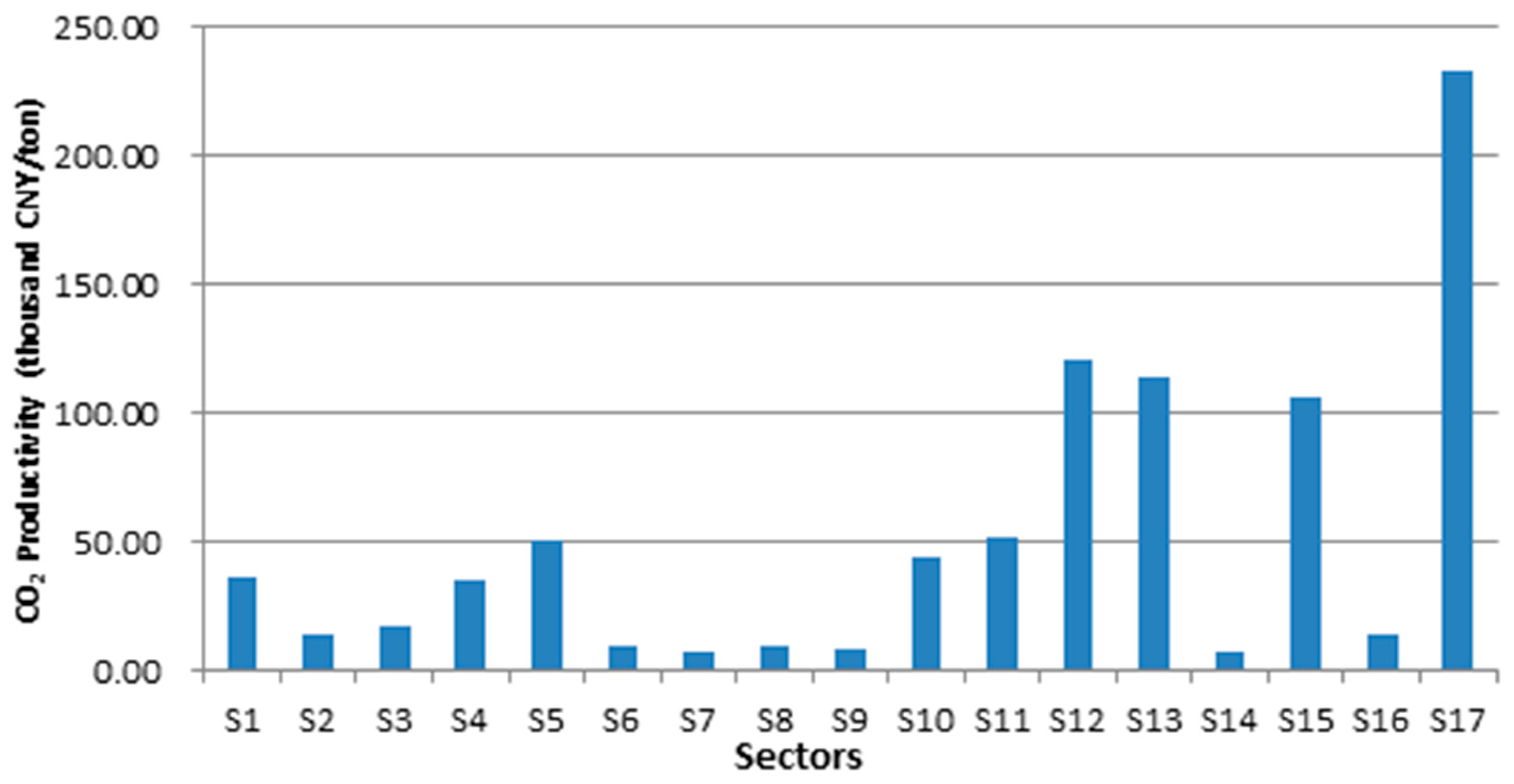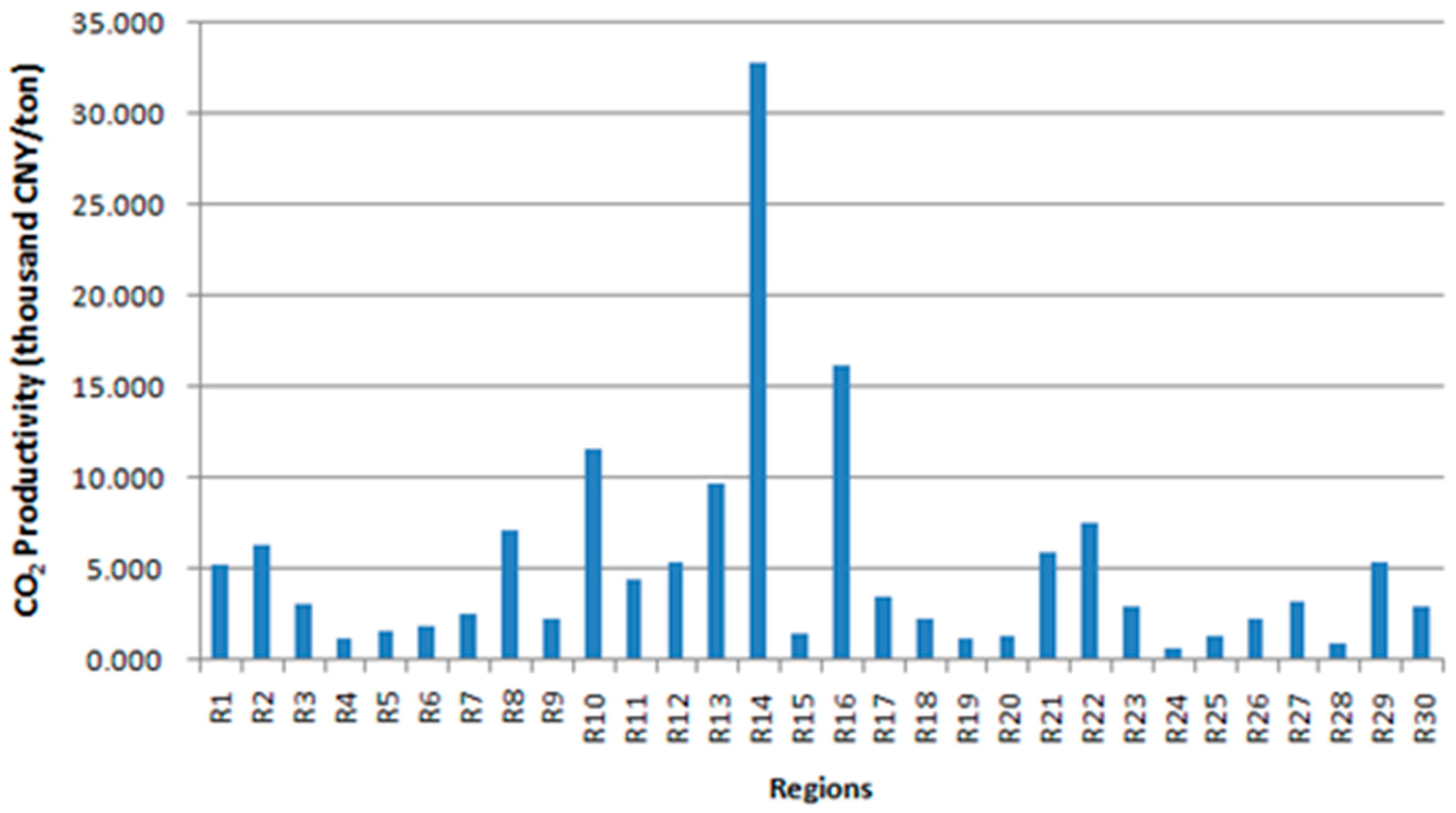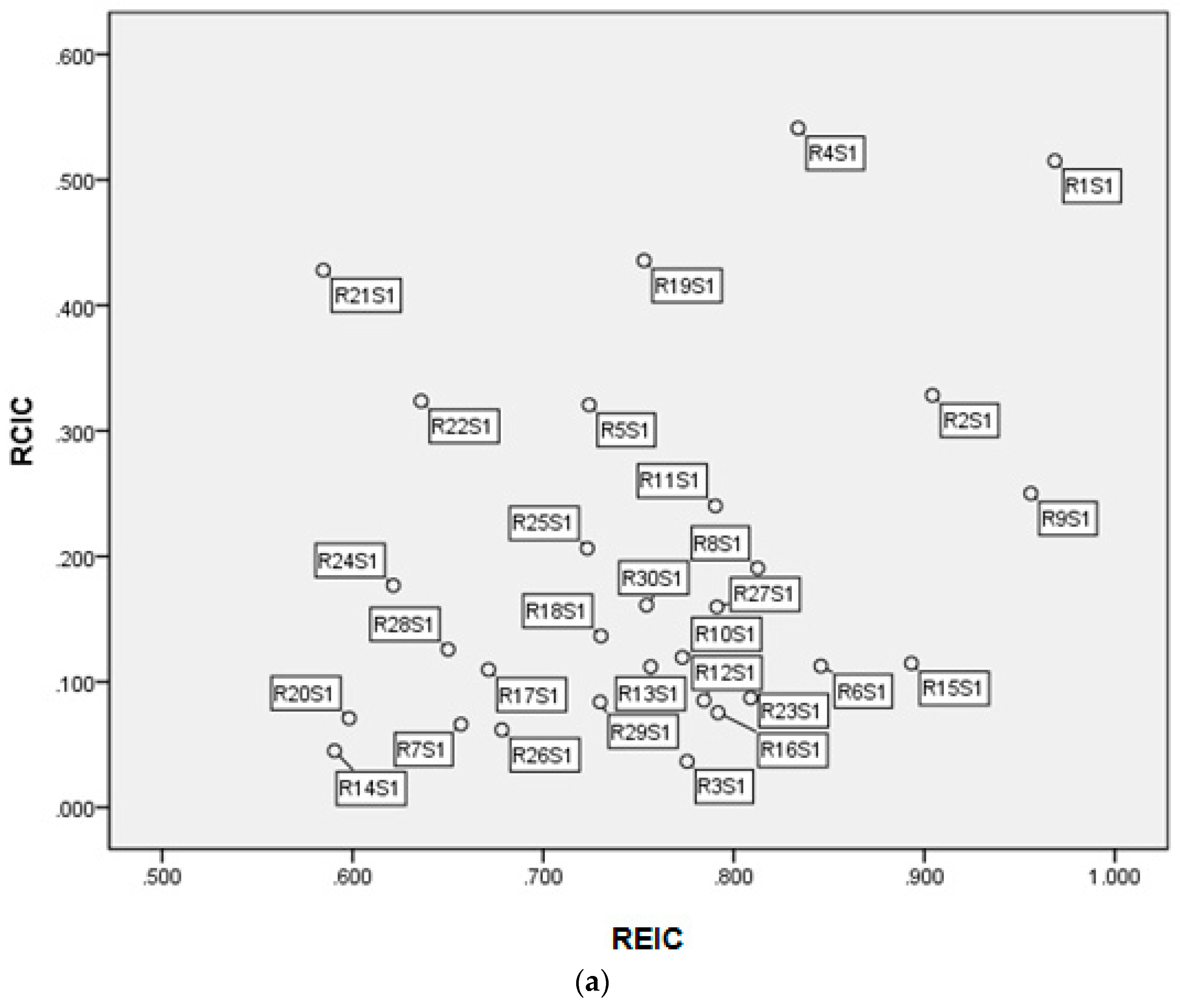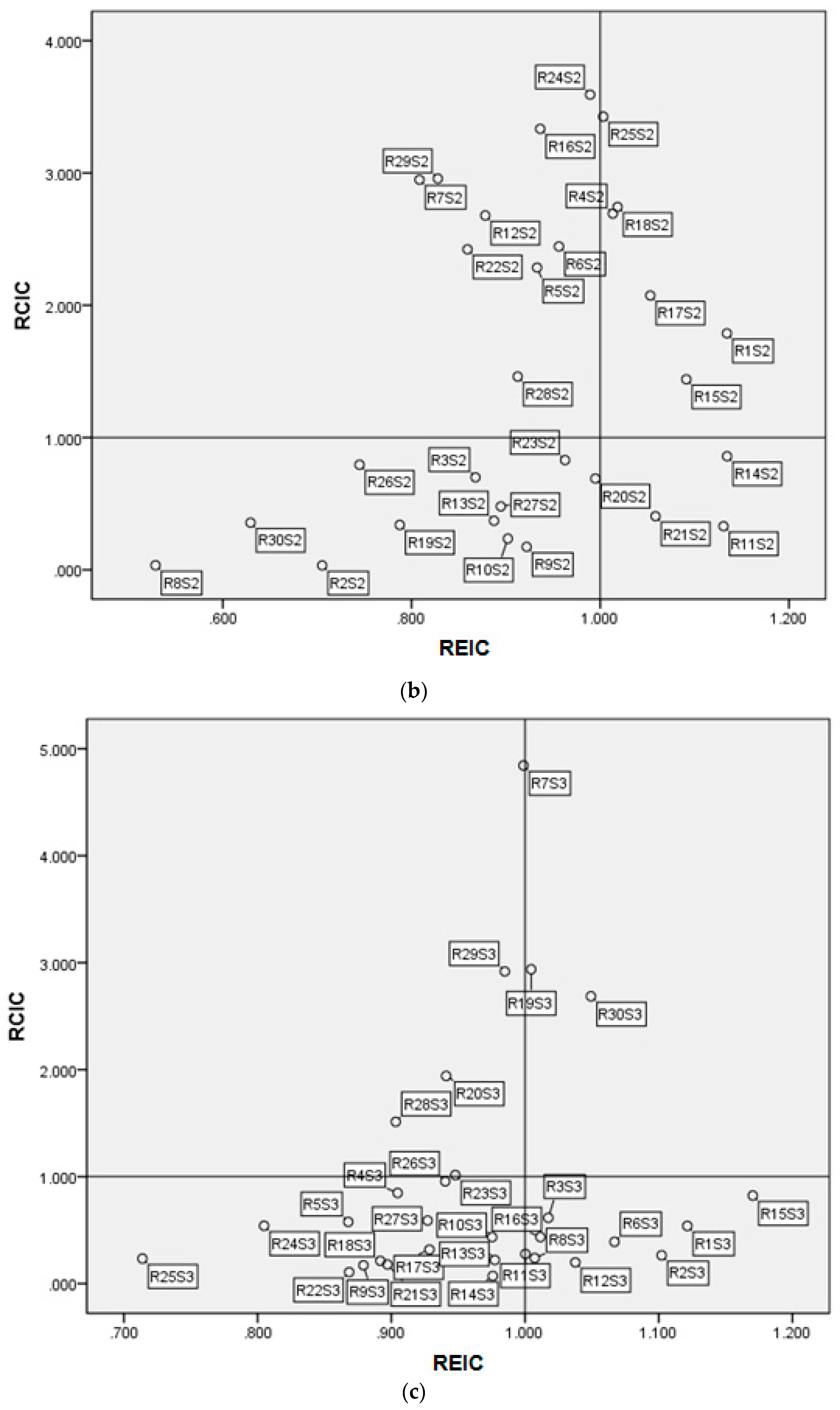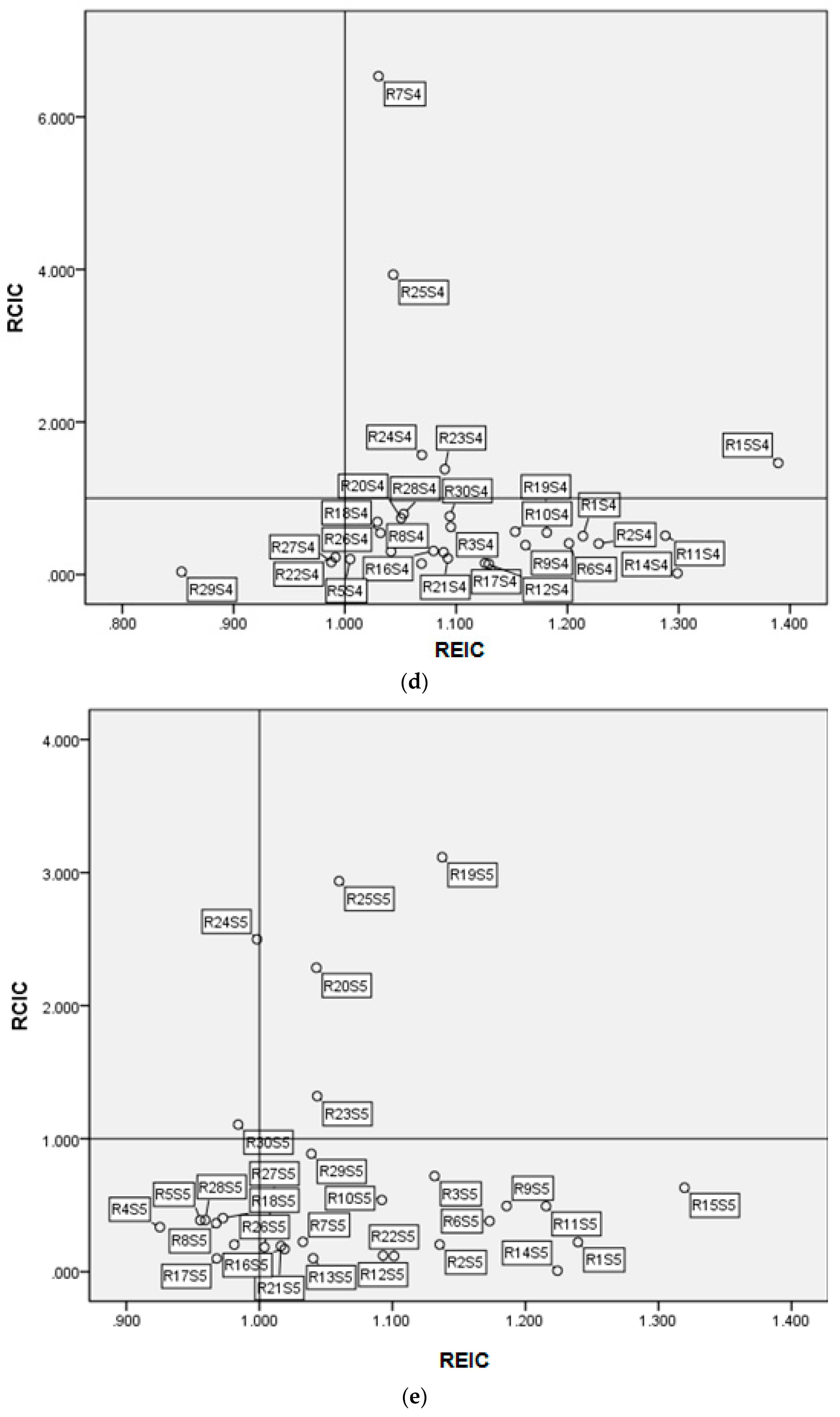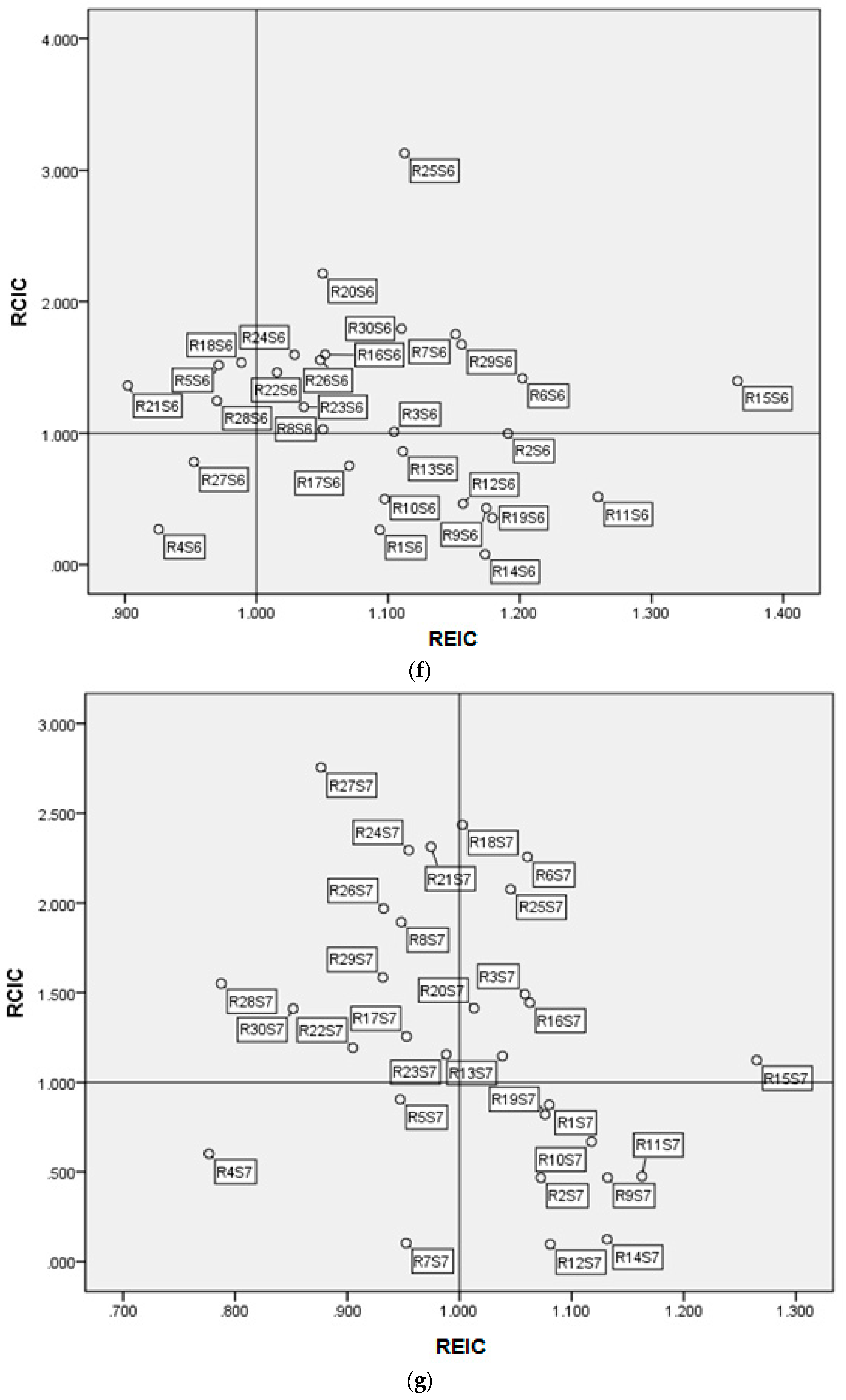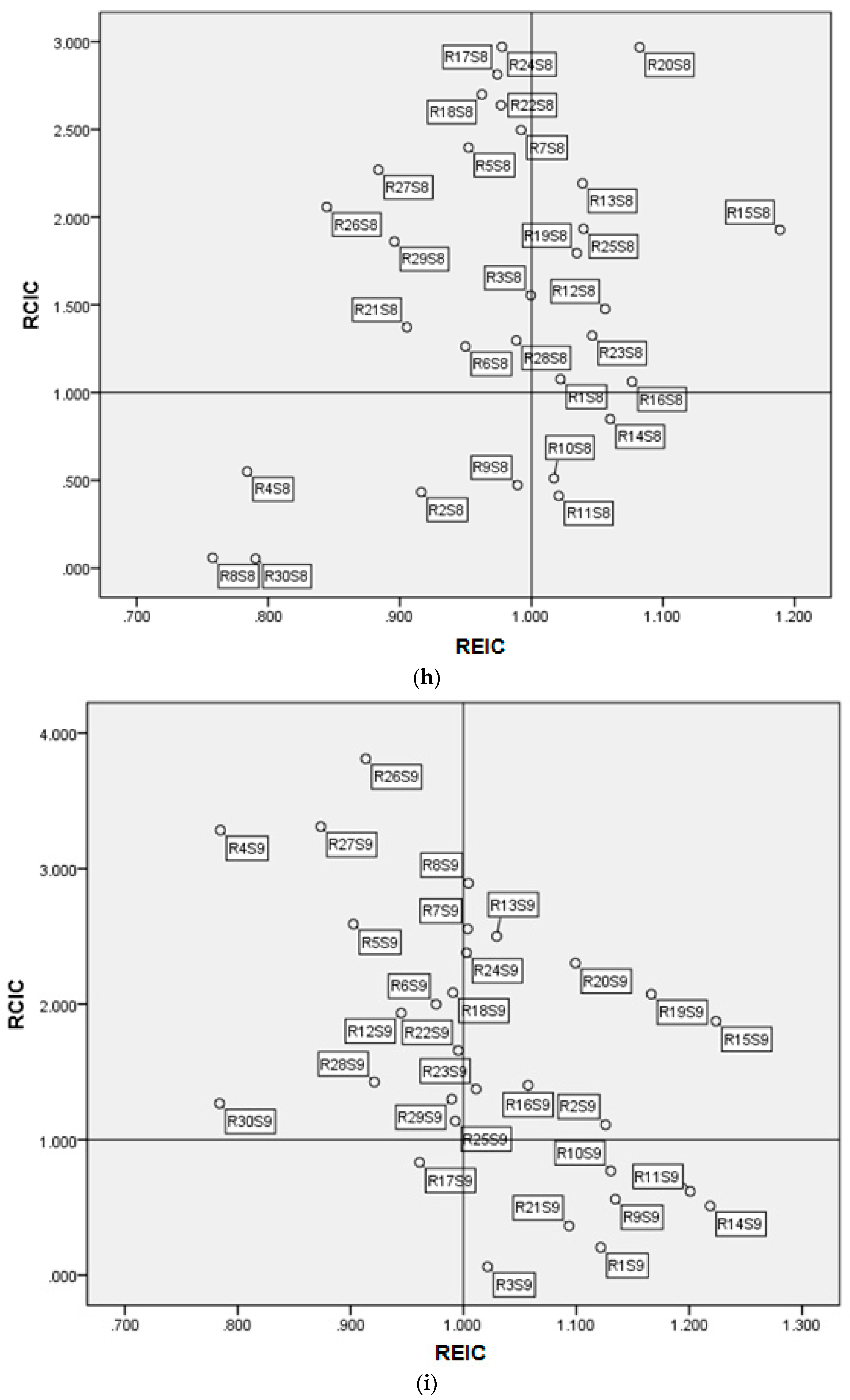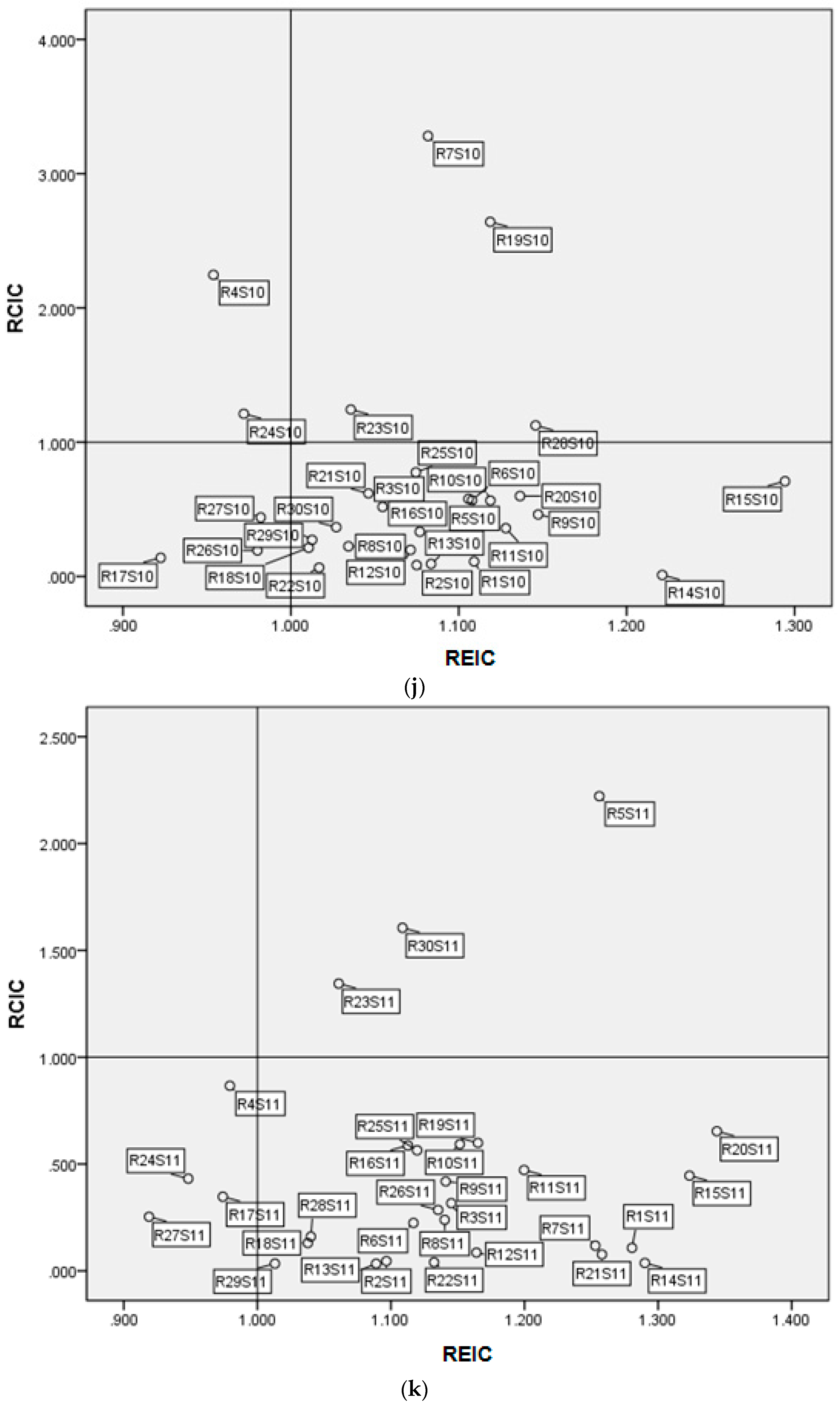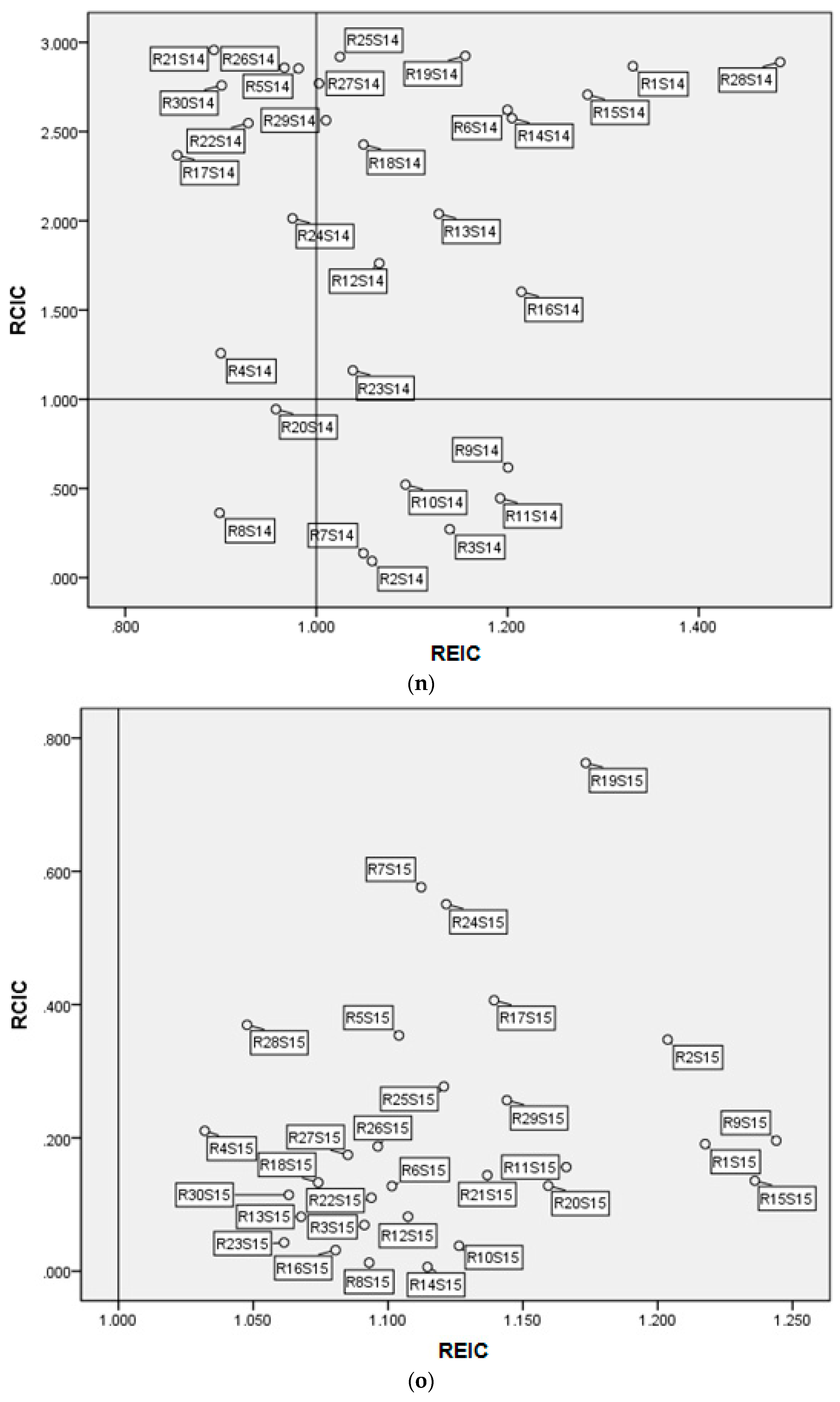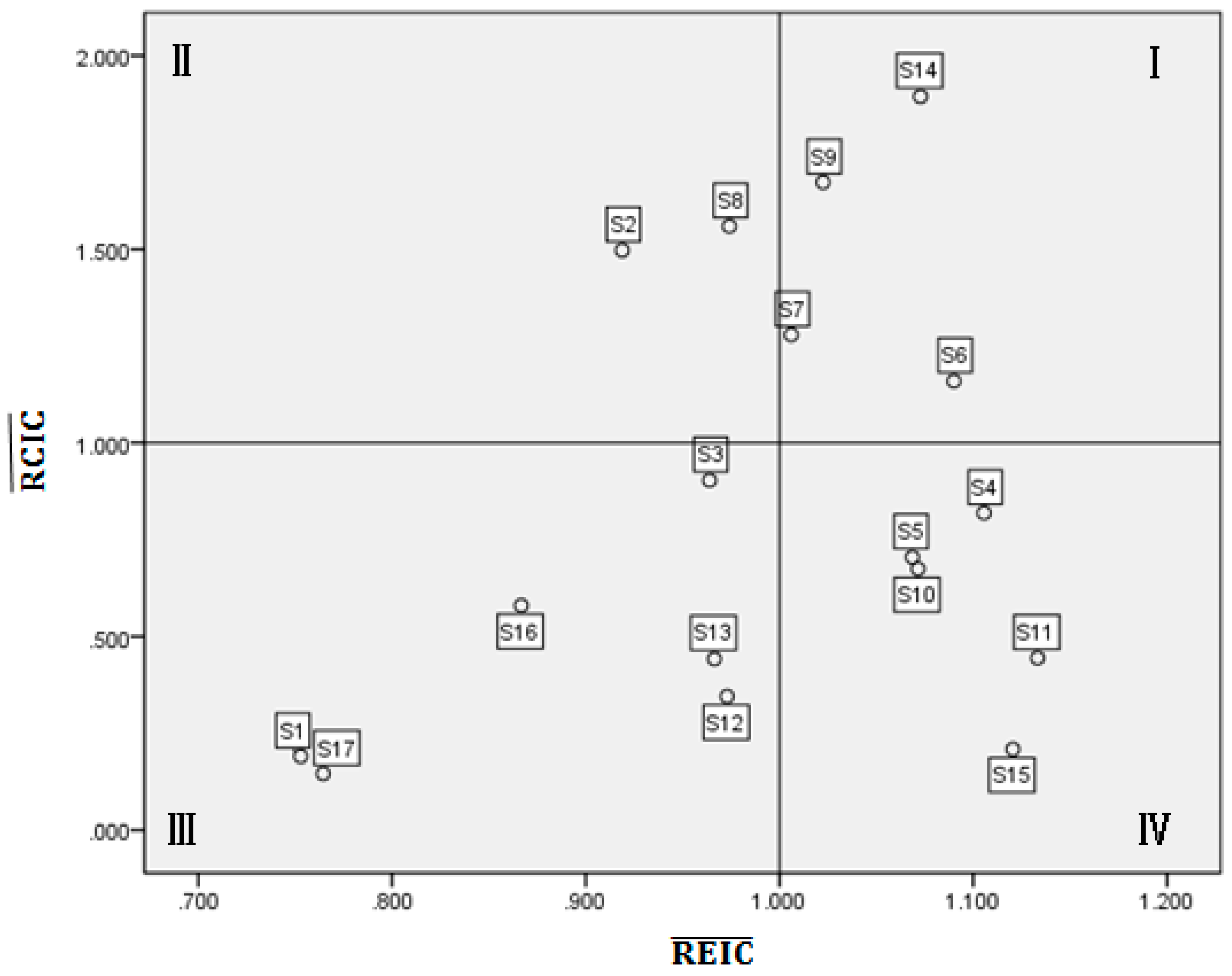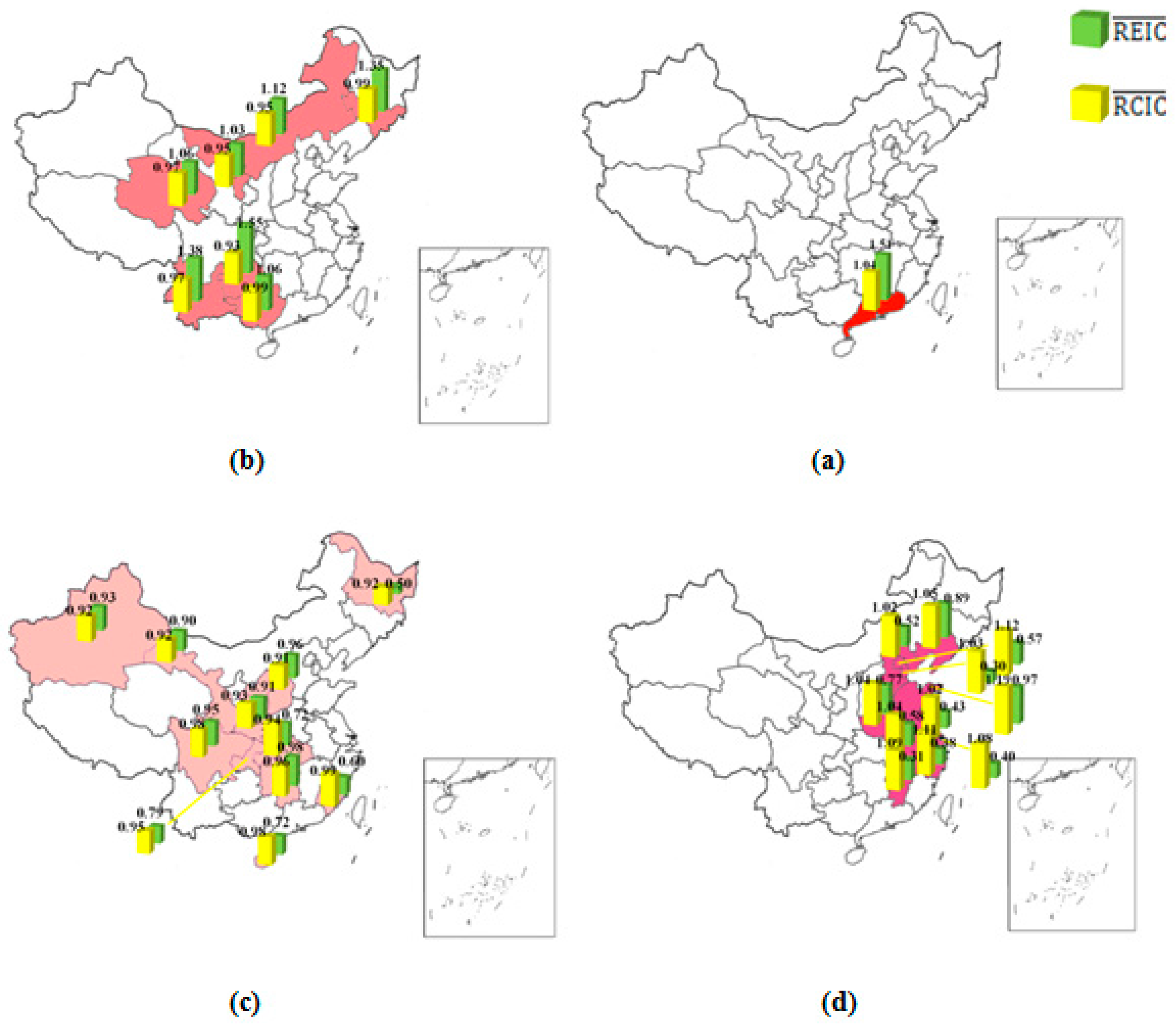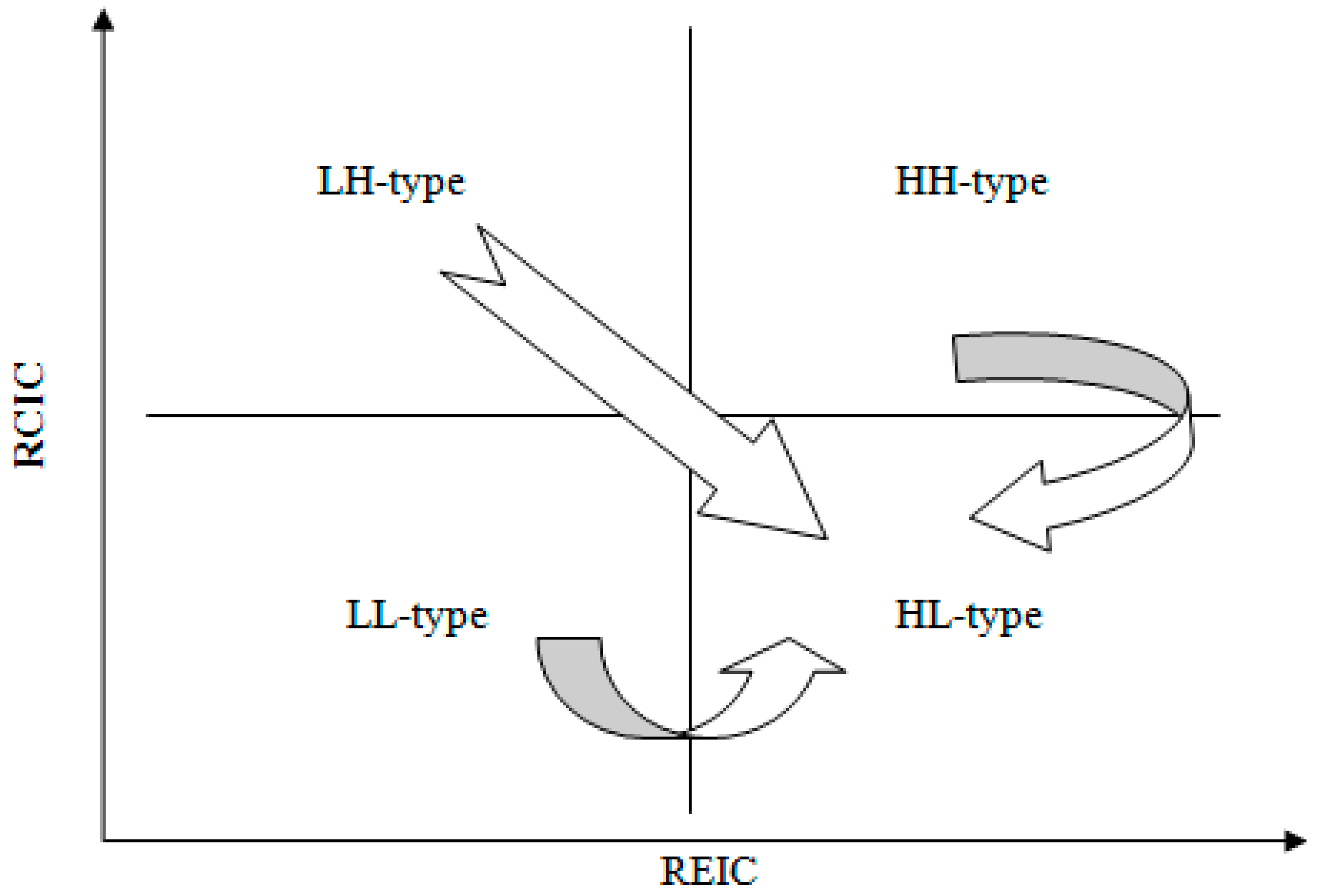1. Introduction
The greenhouse effect is considered one of today’s most important global environmental issues. CO
2 emissions from fossil fuel combustion are believed to be the most important factor contributing to greenhouse gas (GHG) and are responsible for over 60% of this deleterious effect [
1]. China has now become the world’s largest CO
2 emitter [
2,
3,
4,
5,
6,
7]. In 2015, China’s CO
2 emission was 9.125 billion tons, accounting for 27.2% of the world's total emission [
8]. In 2015, at the 21st Conference of the Parties to the United Nations Framework Convention on Climate Change, the Chinese government declared that China would strive to fulfil its commitment to reaching peak CO
2 emissions by approximately 2030, by which point it also aims to reduce its CO
2 emissions per unit of GDP by 60% to 65% of its 2005 level [
9]. Sectoral production plays a leading role in China’s CO
2 emissions [
10]. This is because production activities consume large amounts of energy and because China's energy consumption primarily depends on coal and other fossil fuels [
11]. Specifically, more than half of China’s CO
2 emissions come from the combustion of fossil fuels [
12].
The production sector’s CO
2 emissions are closely related to its energy consumption structure. Sectors with high fossil energy intensity, such as electricity production, transportation and steel production, generate far higher CO
2 emissions than sectors with low fossil energy intensity, such as agriculture and services [
13,
14,
15,
16,
17,
18].The electricity production sector accounted for the largest share (47.2%) of China’s CO
2 emissions in 2002 [
13]. Additionally, the transportation and steel production sectors are also considered highly fossil energy-intensive. For example, the transportation sector accounted for approximately 62% of total national CO
2 emissions in the United States in 2015, as 63.2% of that sector’s energy consumption relied on fossil oil [
16,
19]. It is important to recognize that, in different countries, the use of renewable energy resources can lead to different levels of reduction in CO
2 emissions. In Brazil, CO
2 emissions will be reduced by 20% by 2020 due to the increased use of bio-ethanol and biodiesel in the transportation sector [
17,
18,
19]. Moreover, Germany’s CO
2 emissions (31 million tons) are half of Korea’s (66 million tons) despite similar production levels because steel production in Germany uses the electric furnace route, which relies on renewable energy, while steel production in Korea uses the blast furnace route, which depends heavily on fossil fuel [
20,
21]. Compared to highly energy-intensive sectors, the agricultural sector and the services sector are considered low-carbon production sectors because little fossil fuel is used in their production processes [
22,
23]. However, some studies have indicated that China’s service sector is a high CO
2 emitter because its electricity is produced mostly from coal [
24].
Because different sectors have different CO
2 emissions, the combined structures of different sectors in regions lead to different regional CO
2 emissions [
25]. According to the Energy Information Administration, CO
2 emissions in countries that are members of the Organization for Economic Cooperation and Development (OECD) versus emissions in non-OECD countries were 12,867 million tons and 20,671 million tons in 2015, respectively [
8]. CO
2 emissions in the non-OECD countries were double those of OECD countries. Most non-OECD countries, such as China and India, are developing countries and are pursuing economic growth that is heavily dependent on sectors with high fossil energy intensity sectors [
26,
27]. In China, total national CO
2 emissions were estimated at 8673 million tons, and energy-intensive sectors accounted for 80.91% of these emissions in 2010 [
28]. Moreover, the Central region was the largest CO
2 emitter among China’s 8 regions (Northeast region, North Municipalities region, North Coast region, East Coast region, Central region, Northwest region and Southwest region) [
13]. After China, India is the third largest CO
2 emitter in the world [
2,
29,
30], and the CO
2 emissions of five energy-intensive sectors (iron and steel; cement; chemicals and petrochemicals; pulp and paper; and aluminium) accounted for 56% of its total CO
2 emissions in 2010 [
29,
30,
31,
32].
The single-region input-output (SRIO) model is a widely used approach to estimating sectoral CO
2 emissions because it allows the tracing of both direct and indirect CO
2 emissions in a single sector. Several studies have used an SRIO model to analyse CO
2 emission for sectors in a single region [
33,
34,
35,
36]. However, with the development of interregional and international trade, it is necessary to extend the scope of analysis from a single region to more regions. Thus, the multi-regional input–output (MRIO) model has been widely used for this purpose [
37,
38,
39,
40,
41,
42,
43,
44,
45,
46,
47]. Especially since China became the world’s largest CO
2 emitter, more and more researchers have adopted the MRIO model to study the country’s CO
2 emissions flows at interregional and international levels [
12,
13,
48,
49,
50,
51]. Feng et al. [
12] and Su and Ang [
49] studied CO
2 emissions flows at both interregional and international levels by using the full MRIO approach and the hybrid model, respectively. Furthermore, at the international level, Su and Thomson [
52] and Su and Ang [
53] studied how different assumptions regarding exports and imports affect CO
2 emissions, respectively.Su and Thomson [
52] found that the emission intensity in processing exports is much smaller than those in normal exports when estimating China’s CO
2 emissions. Su and Ang [
53] estimated China’s CO
2 emissions with two different methods, and got two different outcomes; the competitive imports assumption gave a larger estimate than the non-competitive import assumption.
This study provides a theoretical framework to support policy-making for economic development and CO
2 reduction at the sectoral and regional levels. Specifically, we constructed two coefficients (REIC and RCIC) based on the MRIO model to capture the benchmarking sectors and regions with high economic influence and low CO
2 emissions influence in China. Moreover, based on these two coefficients, we propose policy implications for these sectors and regions to help the Chinese government achieve the dual objectives of economic growth and CO
2 emissions reduction. The paper proceeds as follows. In
Section 2, we describe the methodology and data used to examine sectoral influences on the economy and CO
2 emissions. In
Section 3, we present the results from the perspectives of sectors and regions. Finally,
Section 4 concludes the study and provides policy implications.
3. Results
According to Equations (8)–(9), we obtain the results shown in
Appendix Table A3 and
Table A4. To analyze the industrial influences on economic development and CO
2 emissions in the same framework, a matrix is constructed in which the x-axis represents
and the y-axis denotes
. Thus, four quadrants have been formed to define four types of sectors or regions based on
and
, including the HH-type, meaning high
with high
; the HL-type, meaning high
with low
; the LH-type, meaning low
with high
; and the LL-type, meaning low
with low
.
3.1. Sectoral Analysis
According to
Figure 1, there are four HH-type sectors, two LH-type sectors, six LL-type sectors and five HL-type sectors. The average values of
and
in these 17 sectors are 0.992 and 0.854. Generally, most sectors (11 out of 17) are in Quadrants III and IV, which indicates that the development of most sectors in China leads to relatively lower CO
2 emissions in 2010. This affirms that CO
2 emission reduction policies have functioned in most sectors. Regarding the effect of sectoral development on economic growth, about half of the 17 sectors have a relatively strong impact on the macro economy, while the other sectors play a relatively weak role in national economic growth. The top 3
sectors are the transportation equipment manufacturing sector (S11), the construction sector (S15) and the textile and related products manufacturing sector (S4), with
s of 1.133, 1.120 and 1.106, respectively. This means that if the value-added of these three sectors were to increase by 1 unit, China’s total GDP would increase by 1.133, 1.120 and 1.106 units, respectively. The top 3
s sectors are the electricity, heat, gas and water production and supply sector (S14), the metal smelting and products manufacturing sector (S9) and the non-metallic mineral products manufacturing sector (S8), with
s of 1.894, 1.673 and 1.559, respectively. If the value-added were to increase by 1 unit in these three sectors, total CO
2 emissions in China would increase by 1.894, 1.673 and 1.559 units, respectively.
Quadrant I in
Figure 1 shows the HH-type sectors, which include the electricity, heat, gas and water production and supply sector (S14), the metal smelting and products manufacturing sector (S9), the chemical industry sector (S7) and the papermaking and educational products manufacturing sector (S6). They have large positive effects on promoting national economic growth while also significantly reducing total CO
2 emissions. The
s of these sectors are 1.073 for S14, 1.022 for S9, 1.006 for S7 and 1.090 for S6, which are all higher than 1.000. This means that the effects of sectoral growth in these sectors on the national economy are stronger than the average level of the effects caused by all sectors. Due to a strong nexus with other sectors, the HH-type sectors are the key contributors to China’s economic growth. However, accompanied by strong effects on national economic growth, their CO
2 emissions also contribute to the increase in China’s total CO
2 emissions. The
s are 1.894 for S14, 1.673 for S9, 1.279 for S7, and 1.159 for S6. Particularly, S14 and S9 have the highest
s among all the sectors. A high
in these sectors is related to high direct fossil energy consumption as well as high indirect consumption from other sectors with which they share a nexus. For example, coal consumption in 2010 for S14 was 1525.72 million tons, accounting for 48.86% of total national coal consumption; S7 not only has high coal consumption (15% of the national total) but also strongly influences the consumption of petroleum products and electricity [
59,
60].
Quadrant II in
Figure 1 shows the LH-type sectors, including the non-metallic mineral products manufacturing sector (S8) and the mining sector (S2). Similar to the HH-type sectors, S8 and S2 also have high
s, with values of 1.559 and 1.497, respectively, due to their high consumption of fossil energy and a strong nexus with fossil energy-intensive sectors such as the electricity, heat, gas and water production and supply sector (S14). However, the
s of S8 and S2 are lower than 1.000, at only 0.974 and 0.919, respectively. Because of their small effect on national economic growth but large effect on national CO
2 emissions, the LH-type sectors’ development can be considered restrictive.
Compared to the HH-type sectors, the LL-type sectors in Quadrant III in
Figure 1 have low
s and
s. The LL-type sectors include the following sectors: the food and tobacco processing sector (S3), the commercial and transport service sector (S16), the other manufacturing sector (S13), the electric and electronic equipment manufacturing sector (S12), the agriculture sector (S1), and the other services sector (S17). Given their current energy saving and emissions reduction goals, these sectors can be encouraged to a certain extent. The low
in these sectors is due to their weak nexus with other sectors in China. For example, S1 is an upstream sector that promotes some sectors’ development well but has little effect on other sectors’ growth. Furthermore, S3 is strongly linked to S1 with a weak
, which leads to the low
in S3. The low
in S12 is mostly due to the fragmented industry chain. For instance, although China is rich in rare earths, which are important inputs for electric and electronic products, a large portion of products using processed rare earths are imported from foreign countries such as Japan [
62]. Therefore, S12 has a weak nexus with the domestic raw material sectors but strongly depends on foreign imports.
The HL-type sectors in Quadrant IV in
Figure 1 are most worthy of attention. These sectors have strong positive influences on the whole economy while also maintaining low CO
2 emissions; they include the textile and related products manufacturing sector (S4), the timber processing and furniture manufacturing sector (S5), the machinery industry sector (S10), the transportation equipment manufacturing sector (S11), and the construction sector (S15). Especially, S11, S15 and S4 rank as the top 3 among all sectors in the
, while they have low
s of 0.445, 0.209 and 0.819, respectively. These sectors are consistent with China’s development expectations for the near future, namely promoting economic development with low emissions. It is slightly surprising that the construction sector (S15) is a HL-type sector because most studies have indicated that it is a carbon-intensive sector [
63]. This is because the estimate of
for the whole economy is based on the inverse matrix of the matrix of CO
2 productivity. Therefore, if a sector has higher CO
2 productivity compared to the average CO
2 productivity of all sectors, this sector would have a lower
. The CO
2 productivity of the construction sector (S15) was 106.36 thousand CNY per ton at the current price in 2010, while the average carbon productivity was 51.63 thousand CNY per ton at the current price in 2010. Therefore, China’s construction sector (S15) has the low
of 0.209. However, the
and
here only provide an average for the sectors. Each sector in different areas performs differently in both
and
; this is analyzed in
Section 3.2.
3.2. Regional Analysis
Similar to sectoral performance, most regions (22 regions) in China also have low
, according to
Figure 2. There is one HH-type region, seven LH-type regions, eleven LL-type regions and eleven HL-type regions. The average values of
and
in these 30 regions are 1.000 and 0.833. The top 3 regions in terms of
are Shandong (R15), at 1.188; Beijing (R1), at 1.123; and Zhejiang (R11), at 1.110. The top 3 regions in terms of
are Guizhou (R24), Yunnan (R25) and Jilin (R7). The
s of these three regions are 1.154, 1.337 and 1.348, respectively.
Within the HH-type region, only Guangdong (R19) has high
and
simultaneously, as shown in
Figure 2a; the
and
equal 1.043 and 1.312, respectively Guangdong (R19) plays a very important role in supporting the national economy; however, this entails a huge amount of CO
2 emissions. As shown in the map (a) in
Figure 2, Guangdong (R19) is located in the southern coastal area that was one of the first regions to open up in China. Due to its proximity to the special administrative regions of Hong Kong and Macao, Guangdong (R19) has a high level of openness [
64]. The development of the goods trade and the export-oriented processing industry has promoted economic growth in Guangdong. In 2010, Guangdong’s (R19) GDP reached 4.6 billion Yuan at the current price, accounting for 11% of the national total [
64]. At the sectoral level, there are 12 sectors (S3, S4, S5, S6, S7, S8, S9, S10, S11, S13, S14, S15) out of the total of 17 sectors with high
s above 1.000. At the same time, regarding the effect on CO
2 emissions, 7 sectors (S3, S5, S8, S9, S10, S13, S14) in Guangdong (R19) have high
s above 1.000. This means that 40% of the 17 sectors in Guangdong (R19) are HH-type sectors, which makes Guangdong an HH-type region.
Figure 2b shows the LH-type regions, including Guizhou (R24), Yunan (R25), Jilin (R7), Inner Mongolia (R5), Guangxi (R20), Qinghai (R28) and Ningxia (R29). In these regions, the
is lower than 1, while the
is higher than 1. These regions have different locations, as shown in map (b) in
Figure 2: Guangxi (R20) is located in the south, Guizhou (R24) and Yunnan (R25) are located in the southwest, Qinghai (R28) and Ningxia (R29) are located in the northwest, Inner Mongolia (R5) is located in the north, and Jilin (R7) is located in the northeast. However, they all share strong industry and weak service. The
of the other services sectors (S17) in these regions are in the range of 0.594 to 0.772. However, the
s of most industry sectors in these regions are approximately 1.000. Most of these regions have rich mineral resources, and mining and mineral products processing are their key sectors. According to sectoral analysis, the mining sector (S2) is a LH-type sector. This may be one of the main reasons that these regions belong to the LH-type.
Figure 2c represents the LL-type regions, which include Hunan (R18), Shanxi (R4), Sichuan (R23), Xinjiang (R30), Shaanxi (R26), Gansu (R27), Chongqing (R22), Hubei (R17), Hainan (R21), Fujian (R13), and Heilongjiang (R8). For the LL-type regions, both the
and the
are lower than 1. Similar to the LH-type regions, most of the LL-type regions are located in the inland area, where it is difficult to attract capital such as foreign direct investment (FDI) and excellent human resources. In these regions, the light industry sectors have had a relatively better economic effect.
The HL-type regions are shown in
Figure 2d; they include Shandong (R15), Liaoning (R6), Henan (R16), Anhui (R12), Beijing (R1), Hebei (R3), Jiangsu (R10), Shanghai (R9), Zhejiang (R11), Tianjin (R2), and Jiangxi (R14). Most of these regions are located in eastern coastal China, as shown in map (d) in
Figure 2. They have superior trading ports, benefit from many policies supporting economic development, and attract a large amount of capital and talent. In these regions, the industrial structure is reasonable and has a balance of industry and service sectors. Moreover, the
s in most sectors in the HL-type regions are higher than 1. Therefore, these regions promote national economic development significantly. Due to the concentration of capital and talent, production technology has improved rapidly, which not only boosts production efficiency but also improves CO
2 productivity. For example, although Zhejiang (R11) ranks third in
, its
was only 0.380.
3.3. Sectoral-Regional Integrated Economy-Carbon Nexus Analysis
To determine the regular distribution of economic sectors, we observed the economy-carbon nexus from both regional and sectoral perspectives (shown in
Appendix Figure A3a–q).
For the agriculture sector (S1) and the other services sector (S17), the S1 and S17 in all regions are scattered in the LL-type (Quadrant III). This means that the S1 and S17 in all regions exhibit low economic influence and low CO2 emissions influence on other sectors. Therefore, S1 and S17 in all regions should focus on improving their economic influence to transition to the HL-type.
For the mining sector (S2), 21 regions out of 30 regions are scattered in the LH-type (Quadrant II) and the LL-type (Quadrant III). This means that S2 in most regions shows low economic influence. However, the influences of CO2 emissions are different in these 21 regions due to their different energy structures. In addition, the other 3 regions, which include Zhejiang (R11), Jiangxi (R14) and Hainan (R21), belong to the HL-type. Therefore, the energy consumption structures, production technology and industrial chain constructions in these 3 regions can be used as benchmarks for other regions.
For the food and tobacco processing sector (S3), the transportation equipment manufacturing sector (S12) and the electrical and electronic equipment manufacturing sector (S13), most regions are concentrated in the LL-type (Quadrant III) and the HL-type (Quadrant IV). This means that when promoting economic development, S3, S12 and S13 in most regions of China have relatively low CO2 emissions influences. However, their levels of economic influence are different because production technology and industrial structures are different in these regions. Moreover, S3 in 8 regions, S12 in 8 regions and S13 in 12 regions belong to the HL-type, and these regions can be used as benchmarks for other regions.
For the textile and related products manufacturing sector (S4), the mechanical industry sector (S10) and the transportation equipment manufacturing sector (S11), most regions are concentrated in the HL-type (Quadrant IV). For the above three sectors, S4 in 22 regions, S10 in 21 regions and S11 in 23 regions belong to the HL-type. Generally, the development of S4, S10 and S11 in China show high economic influence and low CO2 emissions influence, though there are some regions scattered in the LL-type, HH-type or LH-type. Therefore, S4, S10 and S11 can be considered the priority sectors that that should be supported to promote China's economic development in the future.
For the papermaking and educational products manufacturing sector (S6), 24 regions are concentrated in the HH-type (Quadrant I) and in the HL-type (Quadrant IV). This indicates that S6hasstrongeconomic influence in most regions. Out of these 24 regions, there are 14 regions and 10 regions distributed in the HH-type and HL-type, respectively. This means that S6 in most regions should focus on reducing its CO2 emission influences.
For the chemical industry sector (S7), the non-metallic mineral products manufacturing sector (S8), the metal smelting and products manufacturing sector (S9) and the electricity, heat, gas and water production and supply sector (S14), most regions are scattered in the HH-type (Quadrant I) and LH-type (Quadrant II). This illustrates that these 4 sectors in most regions show high CO2 emissions influence. It is exciting that S7 in 8 regions, S8 in 3 regions, S9 in 7 regions and S14 in 6 regions belong to the HL-type, which can be the benchmark for other regions.
For the construction sector (S15), it is slightly surprising that S15 in all regions is scattered in the HL-type (Quadrant IV). This indicates that S15 has a strong economic influence on both the downstream and upstream sectors. Moreover, in all regions S15 shows low CO
2 emission influences. Similarly, Meng et al. [
13] studied China’s CO
2 emissionsin17 sectors in 2002 and 2007 and found that construction accounted for just 0.8% of CO
2 emissions in 2002 (ranking 10th out of all 17 sectors) and 0.6% of CO
2 emissions in 2007 (ranking 12th out of all 17 sectors). This may be because the estimate of RCICs for the whole economy is based on the Leontief inverse coefficient and CO
2 productivity. Therefore, S15 has a lower CO
2 emissions influence due to its larger CO
2 productivity compared to the average of CO
2 productivities for all sectors.
For the commerce and transportation service sector (S16), there are 24 regions scattered in the LL-type (Quadrant III). Moreover, there is no HH-type region in S16. This means that S16 in most regions has low CO2 emissions influence and low economic influence. It is exciting that in two regions (Beijing (R1) and Shanghai (R9)); S16 belongs to the HL-type and can be the benchmark for other regions.
4. Concluding Remarks
Currently, China faces the dual pressures of economic growth and CO
2 emissions reduction at both the national and local levels. In this study, a MRIO model is used to determine benchmark sectors and notable patterns of regional development for policy-makers. Holistic policy implications are depicted in
Figure 3, in which the LH-type, HH-type and LL-type sectors or regions should be transitioned to the HL-type because the HL-type produces a high economic influence coefficient and a low CO
2 emissions influence coefficient, which is the ideal benchmark.
At the sectoral level, specific policy implications mainly focus on promoting economic influence and reducing CO2 emissions influence.
The HL-type sectors are benchmarking sectors because of their high economic influence and low CO2 emissions influence; they should maintain their current development and continue to enhance their economic influence while reducing their CO2 emissions.
For the sectors with low economic influence, more economic policy implications should be considered. For example, the Chinese government can extend and upgrade the industrial chain in the same region and to the other regions and tighten the relationship between upstream and downstream to enhance the sector’s economic influence.
For the sectors with high CO2 emissions influence, more attention should be focused on how to reduce CO2 emissions in these sectors’ production activities. Specific policy implications include improving energy efficiencies through improved production technology and adjusting the energy consumption structure, especially by enhancing the proportion of clean energy derived from, e.g., wind power and solar power. Moreover, raising the cost of CO2 emissions by implementing carbon taxes and carbon emissions trading is also a useful method because it can force the transition of both the energy consumption structure and improvements to energy efficiency.
At the regional level, both geographic location and preferential policies of the past determine, to a large extent, whether a region can become the HL-type.
The HH-type region of Guangdong can exploit the advantages of its geographical location and early opening-up, acquire the advanced production technology of foreign countries, and adjust its energy structure to reduce its CO2 emissions.
For the inland regions belonging to the LH-type and the LL-type, the most important measures include constructing transportation infrastructure and attracting capital and talent to enhance these regions’ economic influence in the national economy. Moreover, these regions should strengthen communications with the HL-type regions to improve production technology and further reduce their CO2 emissions. Specifically, the LH-type regions should increase the value-added proportion of HL-type sectors in regional GDP.
